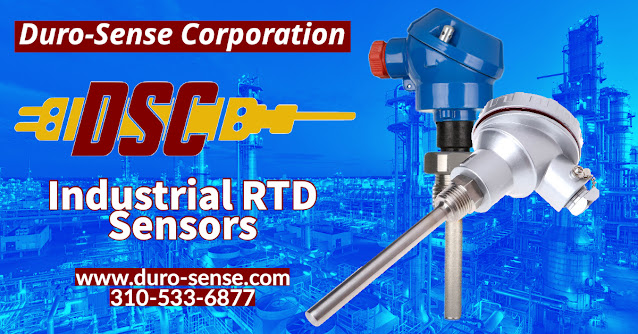A blog providing information about industrial temperature measurement, specifically in the areas of temperature sensors. The posts will contain educational information about thermocouples, RTDs, and other common types of temperature sensors. The application of these sensors will focus on aerospace, aircraft, research and development, medical, chemical, plastics processing, and power generation industries. For more, visit Duro-Sense.com or call 310-533-6877.
Thursday, September 29, 2022
Wire-wound and Thin Film Resistance Temperature Detectors
Thursday, August 18, 2022
Industrial Uses of Resistance Temperature Detectors (RTDs) Explained
Introduction: What is an RTD?
RTDs are sensors that measure the temperature of a material and provide an indication of its resistance to thermal changes.
An RTD is a sensor that measures the temperature of a material and provides an indication of its resistance to thermal changes. RTDs can be manufactured as either a wire or as a thin film on silicon.
The first RTD was developed in 1887 by German inventor Hermann von Helmholtz.
RTDs are typically used in industrial applications such as power plants, refineries, paper mills, and steel mills where they monitor temperatures of process fluids, gases, or equipment surfaces.
RTDs have also been used for years in home appliances like ovens and furnaces to control the temperature inside them.
What is a Typical Industrial Use of RTDs?
RTDs are used in industrial settings to measure the temperature of liquids and gases. This is done by measuring the resistance of a metal element which changes with temperature. RTDs have many applications in industry, such as controlling the temperature of devices, monitoring equipment, and testing for leaks.
Industrial use of RTDs can be found in a wide range of industries. For example, they are used to monitor the temperature of food processing plants and oil refineries. They are also used for quality control purposes in semiconductor manufacturing plants and petrochemical factories.
Other Industrial Uses of Resistance Temperature Detectors
Industrial use of RTDs is extremely common in the manufacturing industry. They are used in industrial processes to measure and control temperature, as well as to detect hot spots and cool spots.
RTDs are also used in many engineering applications such as process control, instrumentation, and automation for a variety of purposes.
Duro-Sense Corporation
310-533-6877
https://duro-sense.com
Saturday, July 30, 2022
Industry Leading Delivery Times for Thermocouples and RTDs
Customers dislike having to wait. Customer happiness and loyalty are directly related to how soon items are delivered.
Friday, July 1, 2022
Saturday, June 25, 2022
Noble Metal Thermocouples
Thursday, May 26, 2022
Custom Temperature Sensor Manufacturing
Wednesday, April 6, 2022
Duro-Sense 100 OHM Platinum RTD Temperature Sensors
RTDs (Resistance Temperature Detectors) are temperature detecting devices that vary their resistance value when surrounding temperature changes. RTD sensing elements use well-known materials that change resistance in a predictable and repeatable manner. Their popularity and general use are outcomes of the RTD's predictability and stability.
The most common type and material of RTD is the 100-ohm platinum sensor. Its use is ubiquitous in the laboratory and industrial process applications going back many decades. The precision, reproducibility, and stability of 100-ohm platinum RTDs (PT100) are well known.
For the most part, resistance temperature detectors (RTDs) fall into two main categories. Thin-film elements are one form of RTD, and wire-wound elements are the other. Each type provides advantages in certain situations and purposes. The more common design, wire-wound, is a length of tightly coiled wire wrapped around a ceramic or glass bobbin. Because the wire and wrapping are delicate, it is usually enclosed in an encased metallic tube to protect them from stress and vibration.
The 100-ohm platinum RTD provides accurate temperature readings with excellent stability and repeatability. They are also very resistant to electrical noise, making them ideal for temperature monitoring in industrial facilities near motors, generators, and high voltage equipment.
The American and European (known as the DIN or IEC standard) 100-ohm platinum RTD standards are the same, with the IEC standard considered the default for PT100. According to the IEC751 standard, the RTD must have:
- The electrical resistance of 100.00 O at 0°C
- A TCR (temperature coefficient of resistance) of 0.00385 O/O/°C between 0 and 100°C.
Because resistance is used to measure temperature in 100-ohm platinum RTDs, the lead wires, connections, and measurement devices contribute extra resistance, requiring external compensation to offset the error. A solution is found by inserting a third or fourth lead wire inversely proportional to the external resistances.
Duro-Sense Corporation
310-533-6877
https://duro-sense.com






